Green Energy for Smart Security Cabin Using Solar Panel
Newsletter
Subscribe now to get notified about IU Nagaland Journal updates!
Search
Green Energy for Smart Security Cabin Using Solar Panel
Arghadeep Ray
MCA Student
Department of Computer Science
ICFAI University Nagaland
Oinam Bhopen Singh
Assistant Professor & Head
Department of computer Science
ICFAI University Nagaland
Abstract
Green energy is a type of energy that is generated from natural resources, such as sunlight, wind, or water. Security cabin is an enclosed space generally used for shop, house, security guard, shop etc. It is providing shelter as well as protection from sun, rain, and cold. They are made from various materials such as mild steel, steel, wood, frp and pvc which protect from dust, moisture, and weathering. A solar panel is a collection of solar (or photovoltaic) cells, which are used to absorb the sun's rays to generate electricity through photovoltaic effect. These cells are arranged in a grid-like pattern on the surface of solar panels.
Keywords
Green energy, Security cabin Smart Security cabin, solar panel, natural resources, solar cell, Solar power, wind power
Introduction
Security cabin is an enclosed space generally used for shop, house, security guard, shop etc. It is providing shelter as well as protection from sun, rain and winter. Security cabins are made of various materials such as mild steel, steel, wood, frp and pvc which protect from dust, moisture, and weathering. The security cabins are designed to protect the occupants from unauthorized intrusion who attempt to enter the premise by force or to monitor who are entering or leaving the premises. Most of the security rooms are mainly located at the main entrance which is at a distance from the main building and a permanent structure are very rare for most institutions. This is where a temporary structure is required, so a portable security cabin become the need of the hours as they can be used for versatile security solutions for a wide range of applications for permanent and temporary facilities. If this security cabin is powered by green energy, it will enhanced the features as it will solve the issue of power outage and will come very handy if it is designed to be portable. Powering the security cabin with green energy like solar energy is really making the whole structure smart with a continuous electric power supply. Smart security is the leader in driving security innovation and its goal is to strengthen security. This Smart Security Cabin is design for the maintenance of ICFAI University Nagaland’s security as right now, the security guard does not have any separate room for maintaining their day-to-day functioning. In fact the security guard has to sit in the entrance of the administrative block instead of the main entrance gate, which leads to lapses in monitoring who are entering the University. But with this security cabin place at the entrance gate most of the problem face earlier will be solved. This structure is designed to be portable which can accommodate one security guard for day time as well as night time duty with minimum and required facility. It has panels and locker to stored duty and entry record files. A small ceiling fan to support the summer heat as well as two bulbs and a charging point is fitted which are powered by the solar panel installed above. This will help the security guard in maintaining a proper record of in and out of people entering the university. It will solve the problem of power cut also. This project is designed with minimum cost factor compared to many of the prefabricated security cabin available in the market with additional transportation charge.
Green energy
Green energy is any energy type that is generated from natural resources, such as sunlight, wind, or water. As a source of energy, green energy often comes from renewable energy technologies such as solar energy, wind power, geothermal energy, biomass, and hydroelectric power. Each of these technologies works in different ways, whether that is by taking power from the sun, as with solar panels, or using wind turbines or the flow of water to generate energy. Main sources of renewable energy:
- Wind Energy.
- Biomass.
- Geothermal Energy.
- Hydropower.
- Solar Energy (Photo voltaic (PV) Cells).

-
Solar Power
This common renewable, green energy source is usually produced using photovoltaic cells that capture sunlight and turn it into electricity. Solar power is also used to heat buildings and for hot water as well as for cooking and lighting.
-
Wind Power
Particularly suited to offshore and higher altitude sites, wind energy uses the power of the flow of air around the world to push turbines that then generate electricity.
-
Biomass
This renewable resource also needs to be carefully managed in order to be truly labelled as a ‘green energy’ source. Biomass power plants use wood waste, sawdust and combustible organic agricultural waste to create energy. While the burning of these materials releases greenhouse gas these emissions are still far lower than those from petroleum-based fuels.
-
Geothermal Energy
This type of green power uses thermal energy that has been stored just under the earth’s crust. Geothermal energy has been used for bathing in hot springs for thousands of years and this same resource can be used for steam to turn turbines and generate electricity.
-
Hydropower
Also known as hydroelectric power, this type of green energy uses the flow of water in rivers, streams, dams or elsewhere to produce energy. Hydropower can even work on a small scale using the flow of water through pipes in the home or can come from evaporation, rainfall, or the tides in the oceans.
Smart security cabin
Smart security cabin is a portable structure which is powered by solar energy generally used by security guard monitoring the security of an institution like school or universities. It also provides shelter as well as protection from sun, rain and winter. It can be transported and placed in any location of the premise.
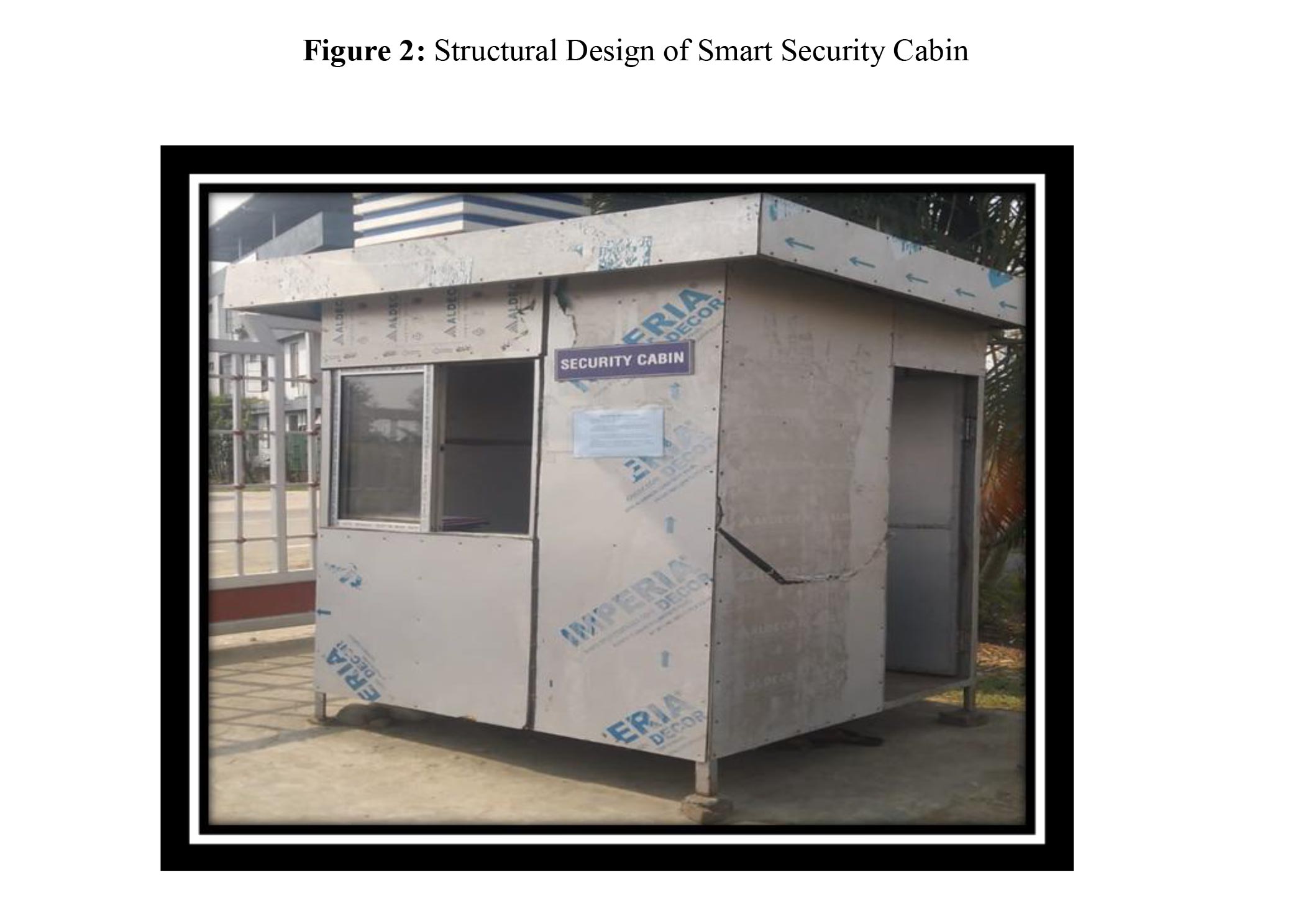 Smart-Security-Cabin-Using-solar-panel-5.jpg" alt="">
Smart-Security-Cabin-Using-solar-panel-5.jpg" alt="">
Solar Panel
A solar panel is a collection of solar (or photovoltaic) cells, which are used to absorb the sun's rays to generate electricity through photovoltaic effect. These cells are arranged in a grid-like pattern on the surface of solar panels.
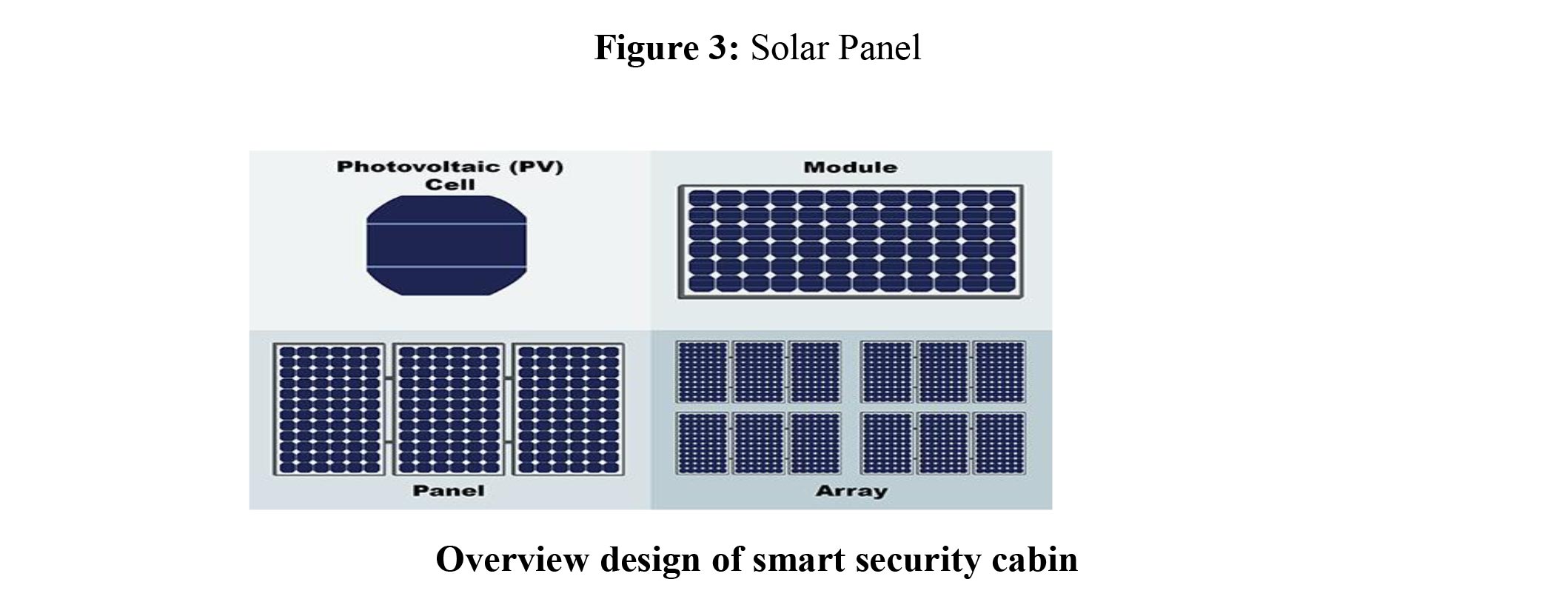
Materials to be used:
To set up a stable and flexible solar power system, we need the following materials.
- Solar Panel
- Solar charge controller
- PV mounting structure
- DC cables
- AC cables
- Normal inverter
- 12V 150AH Battery
- 16A AC MCB (Single phase)
- Civil foundation materials
- Lightning protection unit
- Switchboard for load distribution
Dimension of Smart Security Cabin
Length X Breath X Height = 12´ X 10´ X10´
Condition in installation
Solar panels should be installed south facing in the Northern hemisphere and north facing in the Southern hemisphere. Since India is in the Northern hemisphere, Solar panels will be installed always- South facing in our country. The directions North- South may be found with the help of Magnetic Compass.
Any obstruction (such as tree or building) should be avoided in East, West or South of the place of installation. The following is the criteria:
- (i) East or West: The distance between solar panel and obstruction should be more than double the height of obstruction.
- (ii) South: The distance should be more than half the height of obstruction.
Since there are no obstructions around the place of installation of solar panel in our university, so it is the ideal place for the same.
The support for the Solar panel needs to be a robust one and should not be accessible to general public. It should be so installed that rainwater, bird dropping, leaves etc. do not accumulate and the top surface can be cleaned easily.
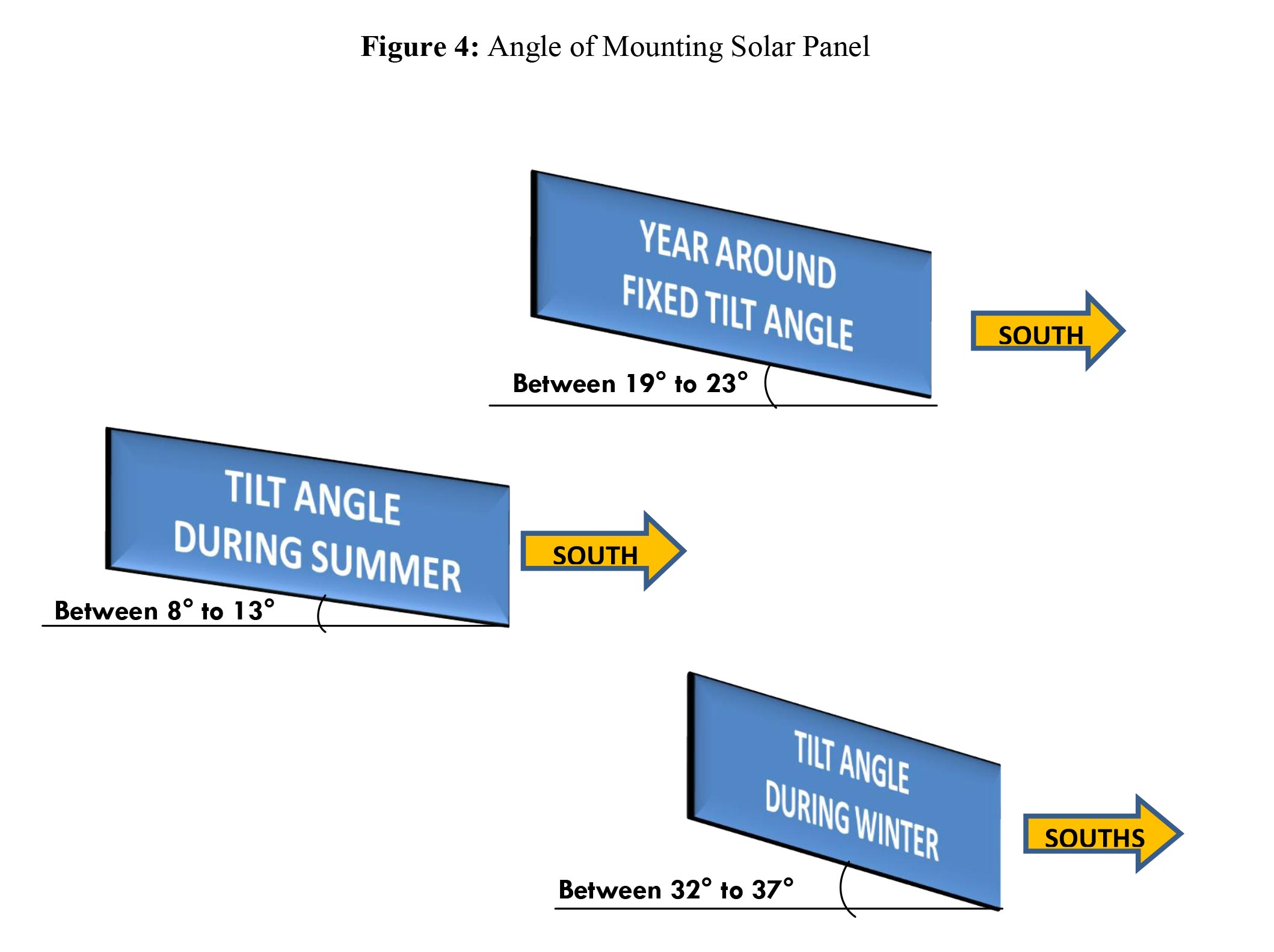
Mounting the solar modules:
While mounting the solar Modules, following points should be considered for getting maximum output from the solar modules:
- Modules should be oriented south facing to receive maximum sunlight.
- The Modules produce more power at low temperature and full sun.
- Tracking the Sun increases the amount of power from an array
The Solar panels are generally installed in such a way that they can receive maximum direct sunlight without shade from any building/trees nearby falling on them at any part of the day.
Economic comparisons
A brief economic comparison of cost and benefit is discussed below:
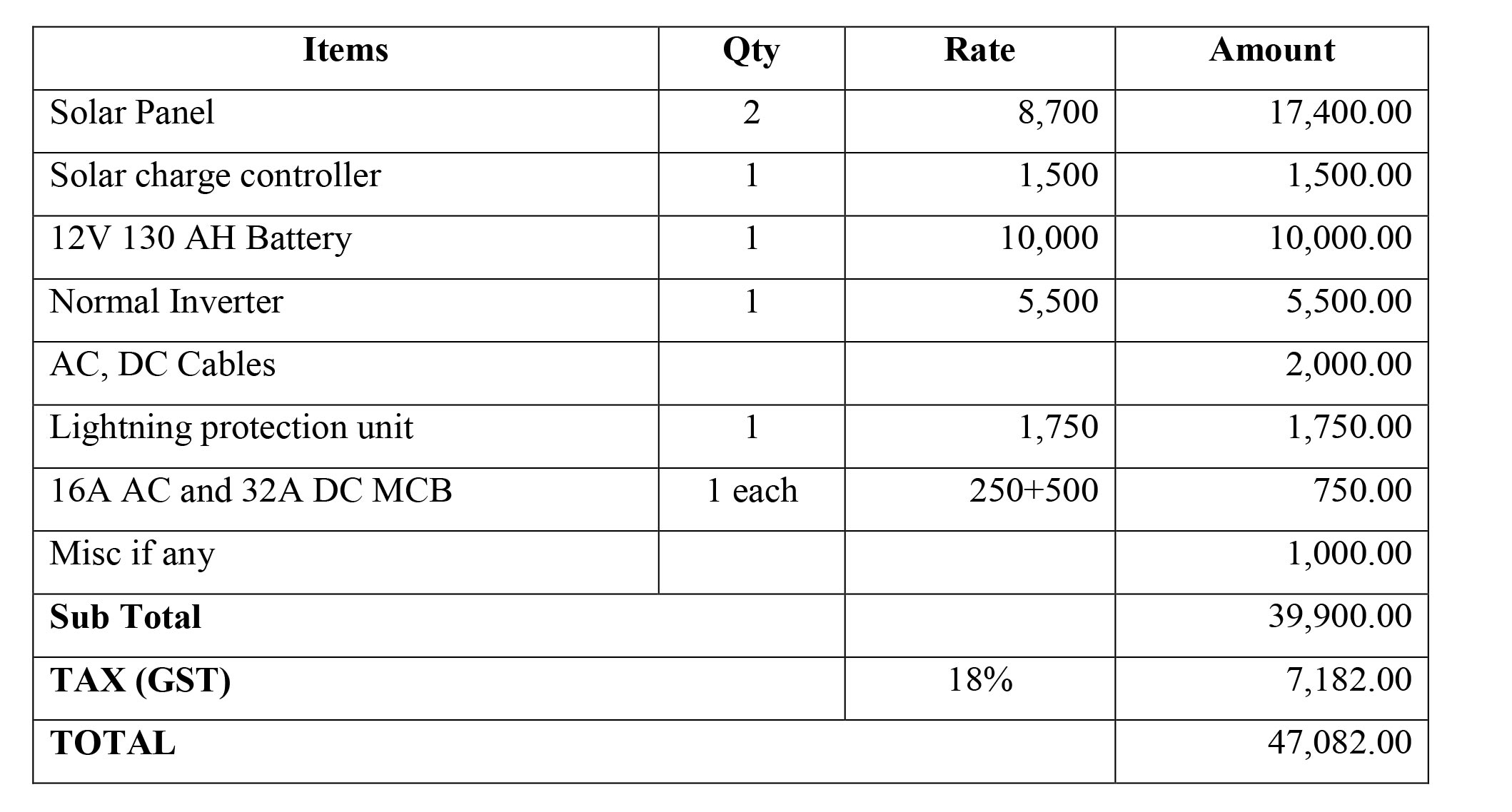
Return of Investment on average daily units’ consumption
Average daily units consumption = 2 unitsRate per unit of electricity as per Bill = 7 Rs (Constant)
Total cost of system = Rs.47082/-
Calculation of ROI for average daily Day consumption
= Total System cost / Average yearly units Consumption cost
= 47082/ (2 x 365 x 7)
The general range for a solar battery’s useful lifespan is between 5 and 15 years. If we install a solar battery today, we will likely need to replace it at least once to match the 25-to-30-year lifespan of PV system. So, considering all, installing Solar System is very much profitable.
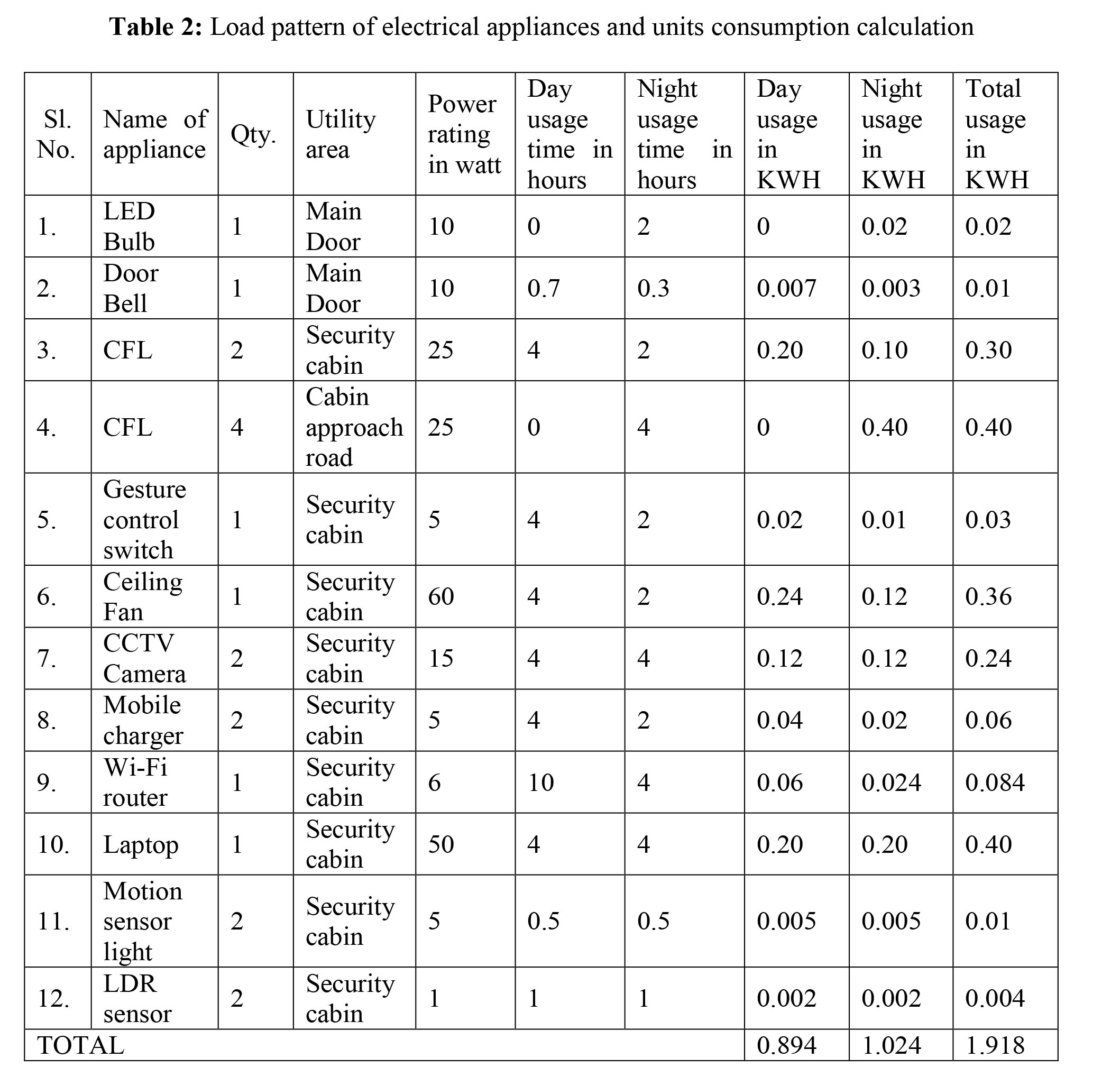
PV design and diagram
PV system design factors:
Latitude and Longitude of site: 25.8374° N 93.7626° E
Average estimated day usage consumption: 0.894 Kwh (Units)
Average estimated night usage consumption: 1.024 Kwh (Units)
Daily average solar peak sun hours (PSH) (MNRE value consider): 5.82 Kwh (STC)
Multi-crystalline Solar Panel rated power: 250 Wp
Battery supply rated voltage: 12 V
Tilt angle of solar PV Array: Between 19° - 23° Fixed mounting angle (Latitude of site)
Inverter efficiency (consider): 90 %
Derated energy output of 250 wp panel
The AC energy output of a solar array is the electrical AC energy delivered to the load at the point of connection of the inverter output to the load.
The output of the solar panel / array is affected by:
- Average solar radiation data for selected tilt angle and orientation;
- Manufacturing tolerance of modules: ±3% (considering worse condition of -3% loss)
-
Temperature effects on the polycrystalline modules: 0.5%/°C above 25° (STC)
For this site: Max Temp is 28.5°C (Weather base data value)
Thereforeloss due to Temp increase = (28.5°-25°) x (0.5) = 1.75 % - Effects of dirt on the modules: 5%
- System losses at inverter end by DC cable : 1% ) & (losses at load end by AC Cables 1%
- Inverter loss : 10 %
- Power considering Loss due to manufacturing tolerance of 3 % =250 x 0.97 = 242.5 Wp
- Power considering loss due to dirt on the modules: 5% = 242.5 x 0.95 = 230.375 Wp
- Power considering loss due to temperature effects on the polycrystalline modules: 0.5%/°C above 25° (1.75 %) = 230.375 x 0.9825 = 226.34 Wp
- System losses at inverter end by DC cable : 1% = 226.34 x 0.99 = 224.08 Wp
- Power loss at Inverter output 10 % = 224.08 x 0.9 = 201.67 Wp
- Power Losses at load end by AC Cables 1% = 201.67 x 0.99 = 199.65 Wp
- Therefore total estimated Derated Energy Output of 250 Wp Panel = 199.65 Wp
- No. of Panel Require for 1Kw Power Out Put = 1000 W / 199.65 W = 5 panels per 1kw
Panel calculation
Daily total no. of estimated units consumption = Day usage units + Night usage units
= 0.894 units + 1.024 units = 1.918 units say 2 units
Daily average sun peak hours (PSH) data of site from MNRE = 5.82
Therefore system size require to generate 2 units per day = 2/5.82 = 0.344 KW
No. of panels required for 0.344 Kw System = 0.344 x 5panel per 1000 watt = 1.72 Panels say 2 Panels
Battery Capacity determination
Battery Size = (1.024 Units night consumption + 0.2048 (20%) unit backup for morning hours)
= 1024 VAh + 204.8 Vah
= 1228.8 Vah / 12 V (battery rating)
= 102.4 AH
Battery efficiency = 80% hence Actual battery size require
= 102.4 x 1.25
= 128 AH say 130 AH
Considering morning backup of battery consumption
Battery Rating = 12 V DC 130 AH
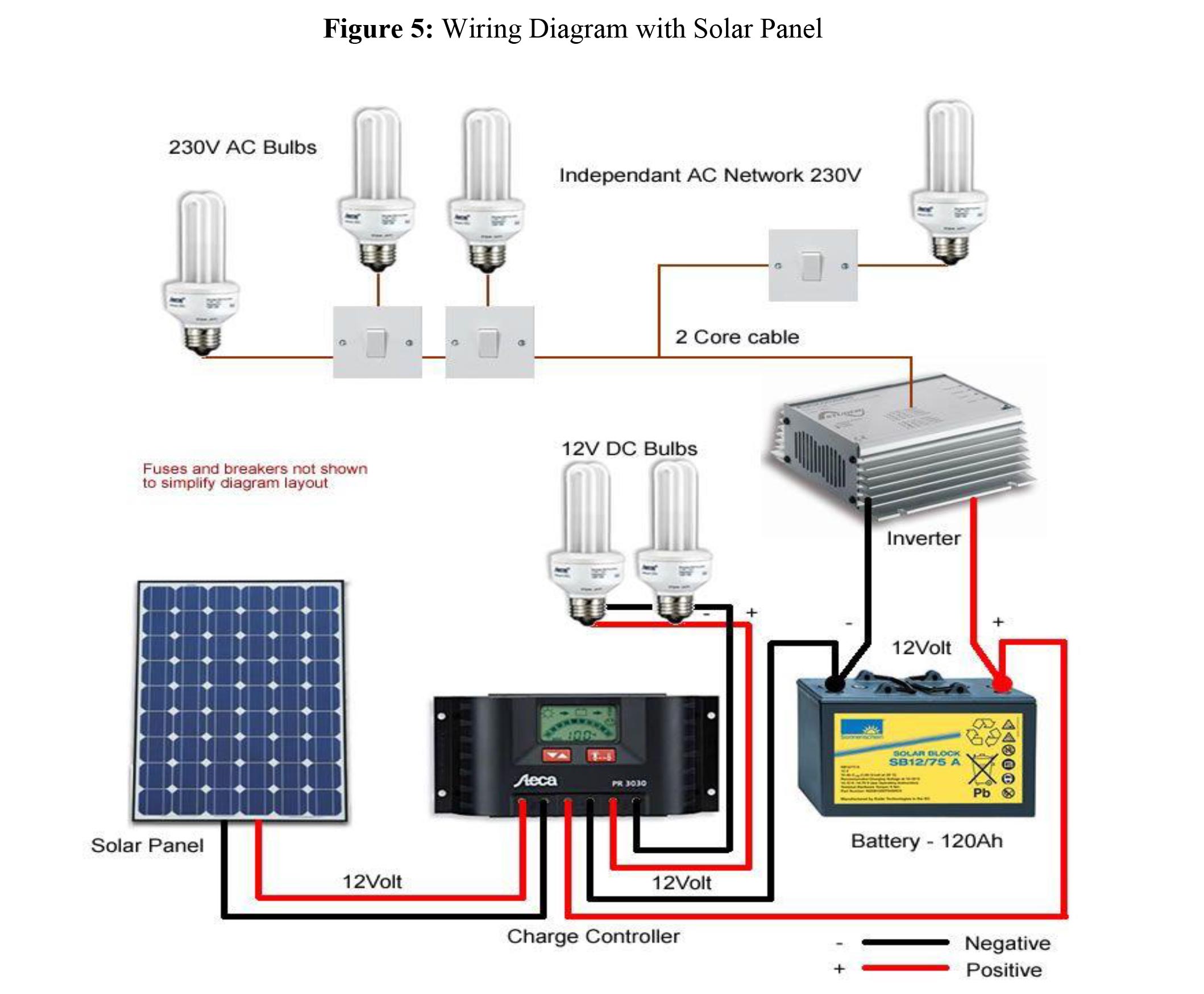
Results and finding
Solar panel output test
To test solar panel voltage output, we have to set multi-meter to the “volts” setting and do the following:
- Touch the multi-meter’s (red) positive lead to the solar panen’s positive wire.
- Then touch, the multi-meter’s (black) negative lead to the solar panel’s negative wire.
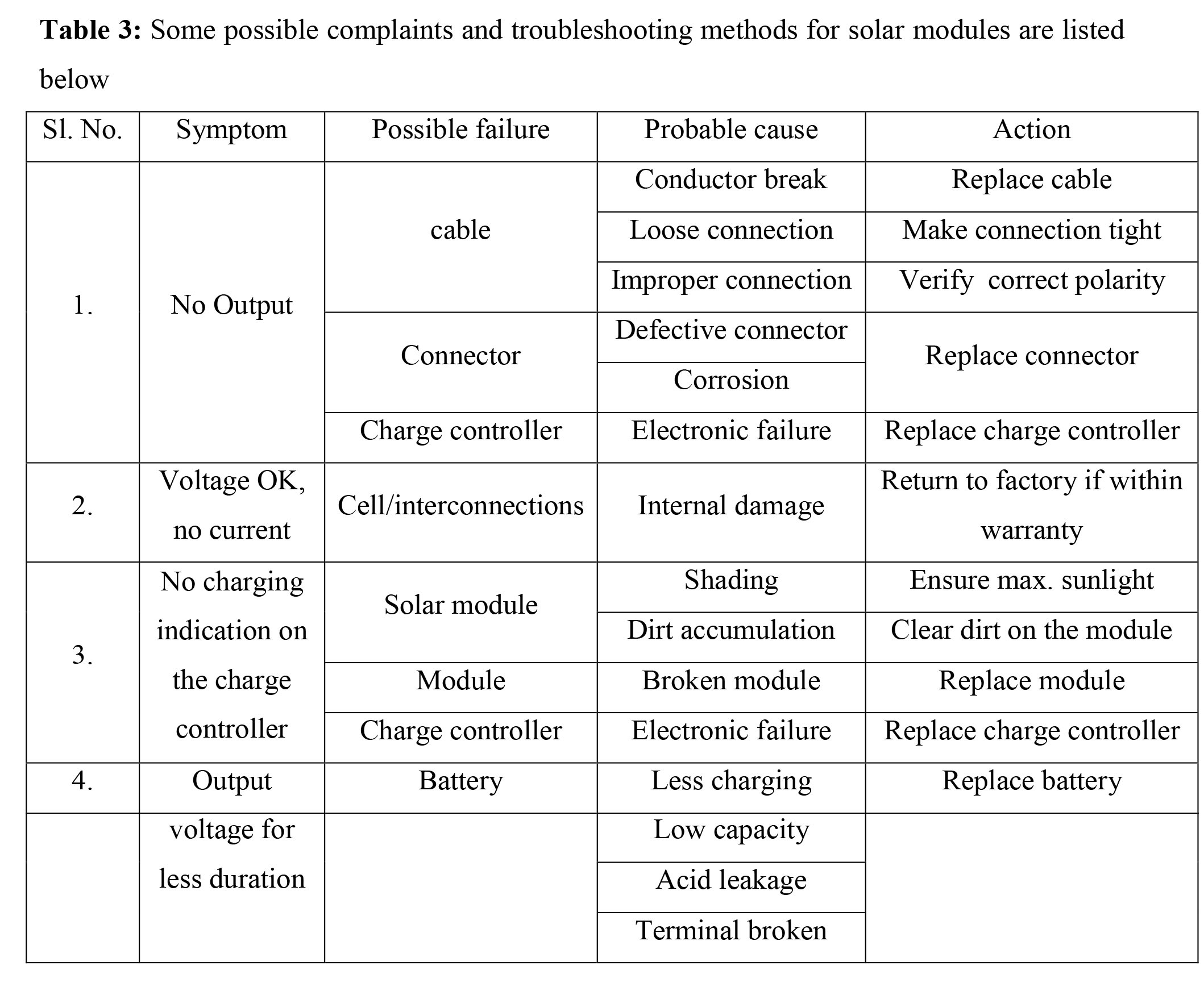
Precautions and Preventive Measures:
- All connections are properly made tight and neat in order to avoid reverse connection.
- The SPV Panel is installed facing SOUTH & with the correct Tilt Angle.
- There is no shadow on any part of the SPV Panel at any time of the day, to get maximum power.
- Battery Bank is placed on a rack or platform insulated from ground and located in a well-ventilated area and also sufficient clearance is there over the battery.
- Charge Controller will be damaged if SPV Array is connected first and then the Battery bank.
Connections:
Switch OFF MCB of Charge Controller before any connection.
FIRST the Battery Bank, then Load is connected to SPV Charge Control Unit and then SPV Panel. For disconnection reverse sequence is adopted.
Switch ON MCB of the Charge Controller when all the connections are thoroughly checked and fuses are placed in the junction boxes.
Conclusion
Solar energy is a clean, pollution free and renewable source of energy. Once a solar panel is installed, solar energy can be produced free of charge. Solar energy will last forever whereas it is estimated that the world’s oil reserves will last for 30 to 40 years. Very little maintenance is needed to keep solar cells running. There are no moving parts in a solar cell which makes it impossible to really damage them. In the long term, there can be a high return on investment due to the amount of free energy a solar panel can produce. PV system is one of the best methods of power generation systems to exist in this era. The usage of solar photovoltaic is being promoted to a high extent by the Ministry of new and renewable energy (MNRE).
References
- TWI Ltd. (2023, March 24). What is green Energy? (Definition , Type, and Examples) https://www.twi-global.com/technical-knowledge/faqs/what-is-green-energy
- Hemant Singh. (2018, March 13) What is the state wise Renewable Energy Potential in India? https://www.jagranjosh.com/general-knowledge/what-is-the-state- wise-renewable-energy-potential-in-india-1520941871-1
- Erach Bharucha (2005). Textbook of Environmental Studies for Undergraduate Courses . Universities Press (India) Private Limited.
- Chandra Bhusan (2014). State of Renewable Energy in India, A Citizen’s Report, Centre for Science and Environment. Centre for Science and Environment.
- Karthik S, Aniket Rawool. (2019). A Brief Study of an Installation of a Rooftop Solar PV System in India. Journal of Energy Research and Reviews 3(4): 1-6, 2581- 8368. https://journaljenrr.com/index.php/JENRR/article/view/56
- Ashok S. (2021 May 14). Solar Energy (Physics). Britannica/Science & Tech. https://www.britannica.com/science/solar-energy
- ACI World, (2019) Smart Security. https://aci.aero/airport-advocacy/security/smart- security/
- Christian, M The history of the invention of the solar panel summary. https://www.energymatters.com.au/panels-modules/ Retrieved 25 March 2023.
- Regen Power. Lifespan of Home Energy storage System . https://regenpower.com/life- span-of-home-storage-system/ Retrieved 25 march 2023.
- Infinity renewable group. How to choose the best battery for a solar energy system. https://infinity-renewables.com/how-to-choose-the-best-battery-for-a-solar- energy-system/ Retrieved 25 march 2023.
- Research Designed & Standards Organization. RDSO- Transforming Indian railways. . Retrieved 25 March 2023.
- Process Industry forum. The five worst nuclear disasters history. https://www.processindustryforum.com/energy/five-worst-nuclear-disasters- history. Retrieved 02 April 2023.
- Generation Solar. (2023) Whats a kWh? https://www.generationsolar.com /admin-utilities-permits-etc /whats-a-kwh/ Retrieved 29 April 2023.
- Bengt Johansson (2013). Security aspects of future renewable energy systems- A shortoverview.ScienceDirect598-603https://www.sciencedirect.com/ science/article.
- Emily Walker.(2023) How efficient are solar panels. https://www.energysage.com Retrieved 29 April 2023.
- e.on next. Your guide to solar panel storage. https://www.eonnext.com/solar- panels/solar-panel-battery-storage. Retrieved 29 April 2023.
- Shakti Sustainable Energy Foundation (2022). Energy Dialogues annual report 2022 https://shaktifoundation.in/wp-content/uploads/2023/06/energydialogues- annualreport2022-online.pdf. Retrieved 10 June 2023.